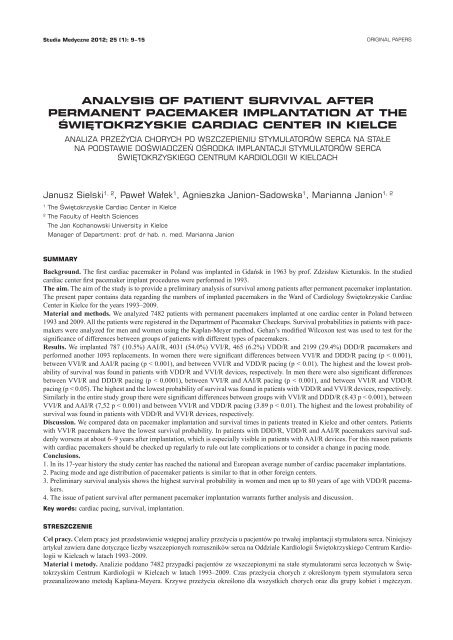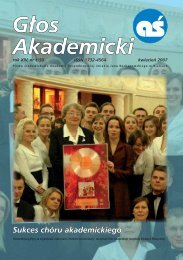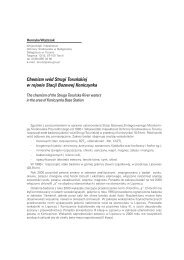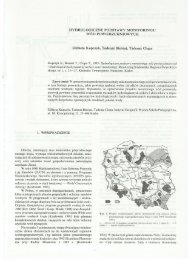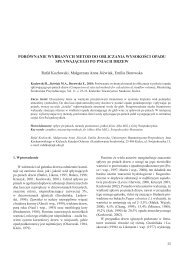25/2012 - Uniwersytet Jana Kochanowskiego w Kielcach
25/2012 - Uniwersytet Jana Kochanowskiego w Kielcach
25/2012 - Uniwersytet Jana Kochanowskiego w Kielcach
Create successful ePaper yourself
Turn your PDF publications into a flip-book with our unique Google optimized e-Paper software.
Studia Medyczne <strong>2012</strong>; <strong>25</strong> (1): 9 – 15 ORIGINAL PAPERS<br />
ANALYSIS OF PATIENT SURVIVAL AFTER<br />
PERMANENT PACEMAKER IMPLANTATION AT THE<br />
ŚWIĘTOKRZYSKIE CARDIAC CENTER IN KIELCE<br />
ANALIZA PRZEŻYCIA CHORYCH PO WSZCZEPIENIU STYMULATORÓW SERCA NA STAŁE<br />
NA PODSTAWIE DOŚWIADCZEŃ OŚRODKA IMPLANTACJI STYMULATORÓW SERCA<br />
ŚWIĘTOKRZYSKIEGO CENTRUM KARDIOLOGII W KIELCACH<br />
Janusz Sielski1, 2 , Paweł Wałek1 , Agnieszka Janion-Sadowska1 1, 2<br />
, Marianna Janion<br />
1 The Świętokrzyskie Cardiac Center in Kielce<br />
2 The Faculty of Health Sciences<br />
The Jan Kochanowski University in Kielce<br />
Manager of Department: prof. dr hab. n. med. Marianna Janion<br />
SUMMARY<br />
Background. The first cardiac pacemaker in Poland was implanted in Gdańsk in 1963 by prof. Zdzisław Kieturakis. In the studied<br />
cardiac center first pacemaker implant procedures were performed in 1993.<br />
The aim. The aim of the study is to provide a preliminary analysis of survival among patients after permanent pacemaker implantation.<br />
The present paper contains data regarding the numbers of implanted pacemakers in the Ward of Cardiology Świętokrzyskie Cardiac<br />
Center in Kielce for the years 1993–2009.<br />
Material and methods. We analyzed 7482 patients with permanent pacemakers implanted at one cardiac center in Poland between<br />
1993 and 2009. All the patients were registered in the Department of Pacemaker Checkups. Survival probabilities in patients with pacemakers<br />
were analyzed for men and women using the Kaplan-Meyer method. Gehan’s modified Wilcoxon test was used to test for the<br />
significance of differences between groups of patients with different types of pacemakers.<br />
Results. We implanted 787 (10.5%) AAI/R, 4031 (54.0%) VVI/R, 465 (6.2%) VDD/R and 2199 (29.4%) DDD/R pacemakers and<br />
performed another 1093 replacements. In women there were significant differences between VVI/R and DDD/R pacing (p < 0.001),<br />
between VVI/R and AAI/R pacing (p < 0.001), and between VVI/R and VDD/R pacing (p < 0.01). The highest and the lowest probability<br />
of survival was found in patients with VDD/R and VVI/R devices, respectively. In men there were also significant differences<br />
between VVI/R and DDD/R pacing (p < 0.0001), between VVI/R and AAI/R pacing (p < 0.001), and between VVI/R and VDD/R<br />
pacing (p < 0.05). The highest and the lowest probability of survival was found in patients with VDD/R and VVI/R devices, respectively.<br />
Similarly in the entire study group there were significant differences between groups with VVI/R and DDD/R (8.43 p < 0.001), between<br />
VVI/R and AAI/R (7,52 p < 0.001) and between VVI/R and VDD/R pacing (3.89 p < 0.01). The highest and the lowest probability of<br />
survival was found in patients with VDD/R and VVI/R devices, respectively.<br />
Discussion. We compared data on pacemaker implantation and survival times in patients treated in Kielce and other centers. Patients<br />
with VVI/R pacemakers have the lowest survival probability. In patients with DDD/R, VDD/R and AAI/R pacemakers survival suddenly<br />
worsens at about 6–9 years after implantation, which is especially visible in patients with AAI/R devices. For this reason patients<br />
with cardiac pacemakers should be checked up regularly to rule out late complications or to consider a change in pacing mode.<br />
Conclusions.<br />
1. In its 17-year history the study center has reached the national and European average number of cardiac pacemaker implantations.<br />
2. Pacing mode and age distribution of pacemaker patients is similar to that in other foreign centers.<br />
3. Preliminary survival analysis shows the highest survival probability in women and men up to 80 years of age with VDD/R pacemakers.<br />
4. The issue of patient survival after permanent pacemaker implantation warrants further analysis and discussion.<br />
Key words: cardiac pacing, survival, implantation.<br />
STRESZCZENIE<br />
Cel pracy. Celem pracy jest przedstawienie wstępnej analizy przeżycia u pacjentów po trwałej implantacji stymulatora serca. Niniejszy<br />
artykuł zawiera dane dotyczące liczby wszczepionych rozruszników serca na Oddziale Kardiologii Świętokrzyskiego Centrum Kardiologii<br />
w <strong>Kielcach</strong> w latach 1993–2009.<br />
Materiał i metody. Analizie poddano 7482 przypadki pacjentów ze wszczepionymi na stałe stymulatorami serca leczonych w Świętokrzyskim<br />
Centrum Kardiologii w <strong>Kielcach</strong> w latach 1993–2009. Czas przeżycia chorych z określonym typem stymulatora serca<br />
przeanalizowano metodą Kaplana-Meyera. Krzywe przeżycia określono dla wszystkich chorych oraz dla grupy kobiet i mężczyzn.


